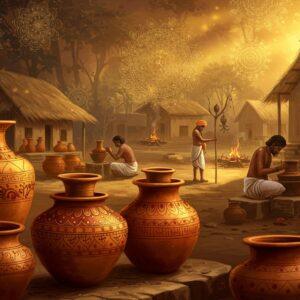
The Yājñavalkya Smṛti holds a revered position in the tapestry of ancient Indian legal and spiritual traditions. This enlightening text, deeply rooted in Dharma, offers a profound understanding of the societal and cultural norms prevalent during its composition. For those who value tradition and seek a deeper connection with their heritage, delving into the Yājñavalkya Smṛti is a rewarding experience.
Unveiling the Historical Significance
The Yājñavalkya Smṛti, composed between the 3rd and 5th centuries CE, provides a glimpse into the socio-political landscape of ancient India. This era, marked by the rise and fall of kingdoms and the prominence of the Gupta Empire, saw the varna system deeply influencing the social order. Rishis, the revered sages, played a pivotal role in preserving knowledge through oral traditions, and the Yājñavalkya Smṛti reflects this rich heritage. This period’s unique blend of political dynamics and spiritual preservation makes the Smṛti an invaluable historical resource. Explore more about historical temples and their significance on our blog.
Core Principles of the Yājñavalkya Smṛti
The Yājñavalkya Smṛti, attributed to the sage Yājñavalkya, masterfully weaves together three core themes: Dharma (righteous conduct), Vyavahāra (judicial process), and Prāyaścitta (atonement). It emphasizes the importance of ethical behavior, legal procedures, and the pursuit of spiritual balance. Unlike other Dharmashastras, it stands out for its systematic approach and its strong emphasis on fairness, justice, and the importance of evidence in legal proceedings. This methodical structure makes the Yājñavalkya Smṛti a significant contribution to ancient Indian jurisprudence. Discover the religious significance of ancient temples on our blog.
Lasting Influence on Legal Thought
The Yājñavalkya Smṛti’s impact reverberates through the ages, profoundly influencing subsequent legal texts and shaping the very essence of Hindu jurisprudence. Authors like Vijnaneswara, in his renowned Mitakshara commentary, drew inspiration from its principles, further solidifying its position as a cornerstone of Hindu law. Its adaptability to changing social and political contexts allowed its wisdom to permeate regional legal customs across India, ensuring its enduring relevance in contemporary Hindu law. The Smṛti continues to be a source of wisdom and guidance for legal scholars and practitioners even today.
Deep Dive into Historical Context and Significance
Originating from the Mithila region, present-day Bihar, the Yājñavalkya Smṛti is a testament to the rich intellectual heritage of ancient India. Composed between the 3rd and 5th centuries CE, it’s attributed to the sage Yājñavalkya, a practice common in Hindu traditions to honor revered figures by associating their wisdom with such texts. The Yājñavalkya Smṛti stands as a pillar of the Dharmashastra tradition, second only to the Manusmriti in its influence. Its legal theories shaped medieval India’s legal landscape, evidenced by inscriptions from the 10th and 11th centuries CE found across India, bearing passages and quotes from the Smṛti.
Structure and Content: A Closer Look
The Yājñavalkya Smṛti is meticulously organized into three distinct sections: Āchāra-kāṇḍa (customs and conduct), Vyavahāra-kāṇḍa (judicial procedures), and Prāyaścitta-kāṇḍa (penance and atonement). Its 1,010 verses (shlokas), known for their clarity and conciseness, address diverse aspects of life, from individual duties and caste regulations to property laws and the intricacies of rituals. This comprehensive approach offers a holistic view of ancient Indian society.
Legal and Social Insights
The Yājñavalkya Smṛti unveils the intricacies of ancient Hindu jurisprudence, providing invaluable insights into the role of law in society. It champions conflict resolution through reconciliation and moral restoration. Moreover, it delves into economic regulations, welfare, and the responsibilities of kingship. A noteworthy aspect is bringing gambling under state control, integrating it into state revenue. Furthermore, the Yājñavalkya Smṛti grants property inheritance rights to widows, a progressive stance compared to the Manusmriti. These aspects highlight its forward-thinking approach for its time.
Comparisons and Enduring Legacy
Often compared with the Manusmriti, the Yājñavalkya Smṛti distinguishes itself through its systematic style and more liberal, humane approach. Its detailed discussions on evidence and the judiciousness of legal documents underscore its emphasis on fairness and justice. The Smṛti has left an indelible mark on later legal texts and judicial decisions, shaping both ancient and modern legal systems. It remains a wellspring of inspiration for discussions on morality, justice, and social responsibility. However, like other texts of its era, it also played a role in reinforcing the caste system within Hindu society.
Enhance Your Spiritual Journey with Poojn.in
Poojn.in offers a wide selection of authentic puja items to enhance your spiritual practice. From beautifully crafted brass puja thalis to fragrant incense sticks, we have everything you need to create a sacred space in your home. Explore our collection of deities and other spiritual products to deepen your connection with tradition.
Conclusion
The Yājñavalkya Smṛti remains a vital link to ancient India’s legal and social heritage. Its influence transcends historical boundaries, informing contemporary interpretations of Hindu law and sparking scholarly discussions. This exploration of the Yājñavalkya Smṛti offers a glimpse into the enduring wisdom of our traditions.


